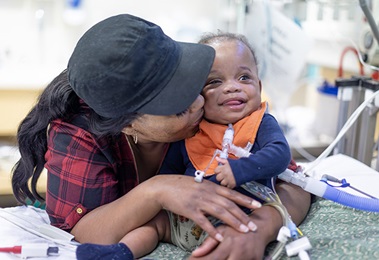Inguinal Hernia in Children
Inguinal (pronounced: ing-gwuh-nl) hernia repair is one of the most common operations that pediatric surgeons perform. It is typically an outpatient procedure performed under general anesthesia in children. The care and operation for inguinal hernias in children differs from that in adults.
What is an inguinal hernia?
A hernia is when there is a hole or weakness in the muscle layer of the abdominal wall. This means that organs or tissues inside the abdominal cavity can poke through the hole and cause the skin to bulge. An inguinal hernia is a hernia that occurs in the groin region. In children these are almost all congenital hernias, meaning that the defect was present from the time the patient was born.
Although the defect was always there, it may not become apparent until something bulges through the hole. Sometimes parents worry that their child lifted something too heavy or strained too hard, causing a hernia to develop, but in almost all cases this is not true. The hernia defect or hole was likely always there since birth. It was only the straining that pushed something through the hole to make it become noticeable.
Why do inguinal hernias occur?
During development in the womb, all babies normally form a short tunnel through the abdominal wall.
Inguinal hernias in baby boys
In boys, this short tunnel connects the abdominal cavity with the scrotum. During development in the womb, the testicles initially grow inside the boy’s abdomen (tummy), descend through this tunnel to end up in his scrotum.
Inguinal hernias in baby girls
In girls, the short tunnel connects the abdominal cavity with the labia. In both boys and girls, this tunnel is supposed to seal off prior to the baby being born.
If it fails to close before birth, then the child is at risk of having an inguinal hernia. Given this, it is not surprising that inguinal hernias are more common in premature infants.
How are inguinal hernias diagnosed?
Most hernias are discovered by seeing or feeling the bulge. Parents or caregivers might be the first to notice, although many times it is the pediatrician or other primary care provider who will find the hernia. In older children, the patient may be the first person to know that something is not quite right. When a hernia is suspected, the patient is referred to a surgeon to confirm the diagnosis and to discuss management plans with the family.
Despite all the high tech advances in health care, the diagnosis of a hernia is best made by a careful examination of the patient. While ultrasounds and various X-ray tests can be used to help determine if a hernia exists, they are rarely necessary and often add additional risks, stress and costs to the child’s care that can be avoided by simply having the child examined by an experienced surgeon.
Why do we fix inguinal hernias?
Before answering that question, it is important to understand how we classify hernias. Hernias fall into three categories.
- Reducible hernias: These are hernias in which the bulging intestine can be pushed back in. Most hernias are reducible. One can often feel or hear a “squish” as the hernia is reduced (pushed back in). This feeling and sound is the actual intestine being pushed back through the hole in the muscle layer. Many hernias that are pushed back in pop right back out when one lets go. This is especially true if the child is crying. Although the hernia won’t stay “in” or the bulge will not disappear, this is still considered a reducible hernia because it is possible to compress it. Reducible hernias generally don’t cause a patient much pain, but these types of hernias can be mildly uncomfortable at times.
- Incarcerated hernias: These are hernias that cannot be pushed back in; the intestine or tissue that came out of the hole in the muscle layer is now stuck. Incarcerated hernias are worrisome since it places the child at-risk for having a strangulated hernia (see below). A child with an incarcerated hernia may complain of pain in the area. The bulge may be tender to the touch and there may be areas of swelling or redness around the bulge. The child may also experience vomiting or pain in the abdomen (tummy). If the child has an incarcerated hernia, he or she needs to see a doctor right away. Sometimes a doctor can push the hernia back in and relieve the incarceration; otherwise the child may need an operation right away.
- Strangulated hernias: If a hernia becomes incarcerated it is possible that its blood supply can be choked off, becoming a strangulated hernia. A strangulated hernia is an emergency and requires an immediate operation to help save whatever tissue or organ is being choked off in the hernia. Patients may become very ill as a result of the strangulated hernia.
Since inguinal hernias will not close on their own, generally all should be repaired. Of course, some children have health conditions that make surgery very risky, but for everyone else hernia repair is recommended. The main reason that hernias are fixed is to prevent the problems that can arise from incarceration or strangulation of the hernia.
How are inguinal hernias repaired?
During the initial meeting with the surgeon, he or she will review the child’s health, confirm the presence of a hernia, and determine if any additional testing is necessary prior to the repair. The surgeon will review the risks, benefits, alternatives, outcomes and complications of the various treatment options with the patient and family. If the patient requires surgery, a surgery can be scheduled at this appointment.
In children, these operations are performed under general anesthesia and are generally done as an outpatient procedure, meaning the patient comes in and goes home on the same day.
There are three different approaches to pediatric hernias:
- Open repair: This involves making an incision just below the belt line and dissecting down to the hole in the muscle layer. This hernia is closed with stitches. The deeper tissues and skin are then sewn together with dissolvable sutures that are hidden under the skin so that there are no stitches to be removed. In teenagers, it is sometimes necessary to use a patch to help repair the hernia.
- Open repair with laparoscopic exploration: This is the same as the open repair except that before closing the hernia hole, a small camera (about 3 mm in diameter) is passed into the abdomen to examine the opposite groin from the inside. The surgeon will recommend this laparoscopic exploration in certain circumstances to rule out a potential hernia on the opposite side. If a hernia is detected, a matching incision is made on the opposite side to allow repair of the second hernia.
- Laparoscopic repair: In this approach the hernia is closed using laparoscopic techniques. A 3-mm or 5-mm camera is inserted through the belly button and additional instruments are introduced through needle holes to perform the hernia closure. There a number of different laparoscopic hernia repair techniques in children (such as eversion technique, intracorporeal suturing technique, and single stitch technique) that a surgeon can use depending upon the particular patient.
What can families expect after their child's procedure?
After a hernia operation, the patient will have some pain. Many times this is controlled with over-the-counter pain medicines, but in some cases prescription pain medicine will be prescribed. Expected recovery time for children is typically 2-3 days, and the child may need to rest at home for up to a week before returning to school. Expected recovery time for teens may be 5-7 days. Patients will likely have to refrain from full strenuous activities for a month.
More Information about Inguinal Hernias









